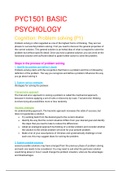Other
tutorial letter + examination guideline
- Institution
- University Of South Africa (Unisa)
THIS DOCUMENTS CONTAIN EXAMINATION GUIDELINE, MODULE RELATED RESOURCES FOR THE CHE1502 MODULE, ASSESSMENT METHODS AS WELL AS BRIEF GUIDELINE FOR EVERY CHAPTER YOU NEED TO STUDY FOR CHE1502
[Show more]



